Entrepreneurship: Managing Human Capital Report Analysis
VerifiedAdded on 2022/08/18
|11
|2513
|10
Report
AI Summary
This report delves into the crucial role of human capital in entrepreneurship. It examines the importance of employer branding, emphasizing the need for a positive work culture and content to attract potential employees. The report further explores strategies for attracting and retaining knowledgeable workers, highlighting the significance of factors such as company reputation, career growth, and employee involvement. Additionally, it addresses the specific needs and preferences of Generation Y employees, focusing on motivation, work-life balance, and the importance of meaningful work. The report concludes by synthesizing these concepts, stressing the need for effective human resource management to create a sustainable and competitive environment for entrepreneurial ventures. The report is contributed by a student and available on Desklib, a platform providing AI-powered study tools for students.
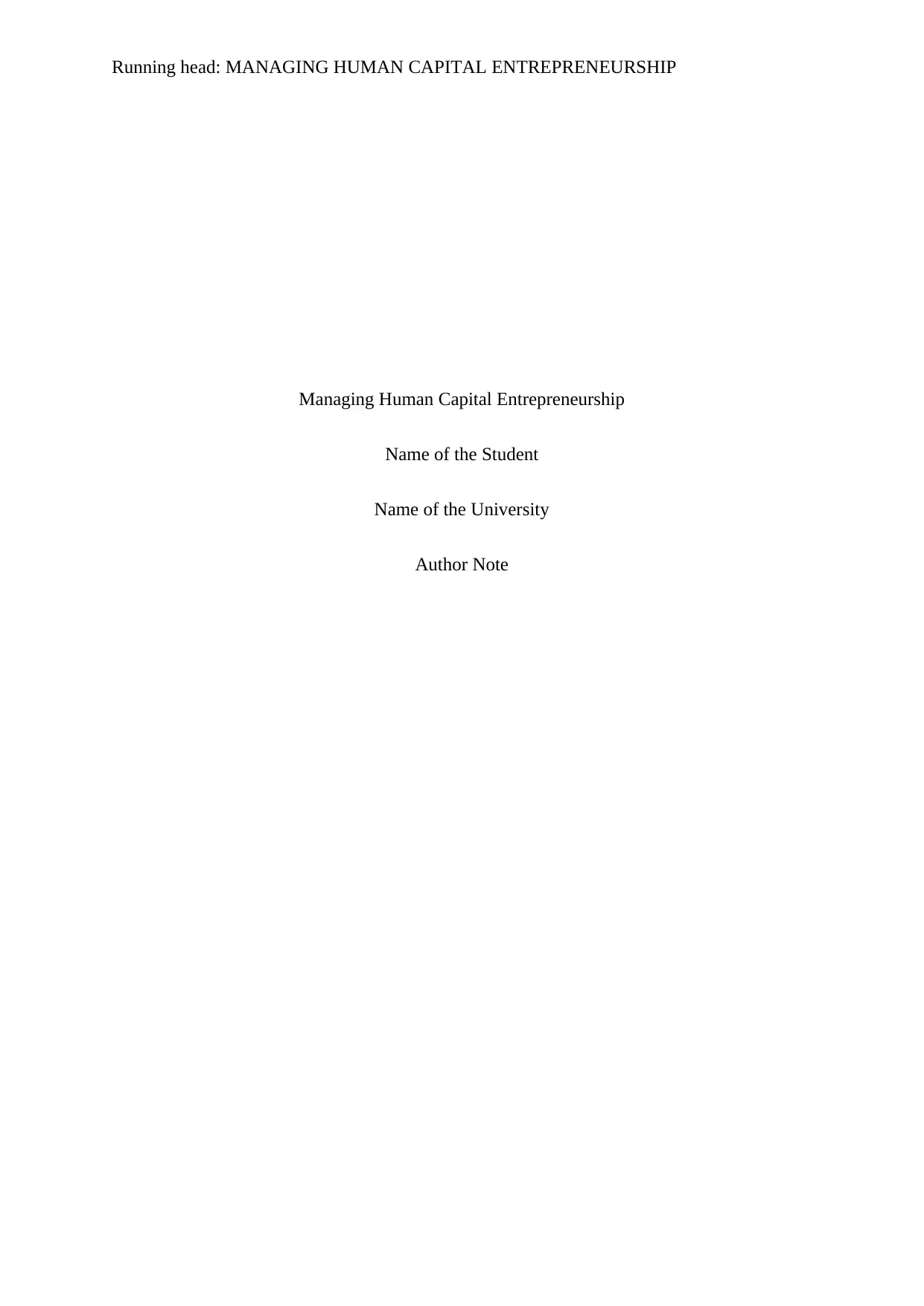
Running head: MANAGING HUMAN CAPITAL ENTREPRENEURSHIP
Managing Human Capital Entrepreneurship
Name of the Student
Name of the University
Author Note
Managing Human Capital Entrepreneurship
Name of the Student
Name of the University
Author Note
Paraphrase This Document
Need a fresh take? Get an instant paraphrase of this document with our AI Paraphraser
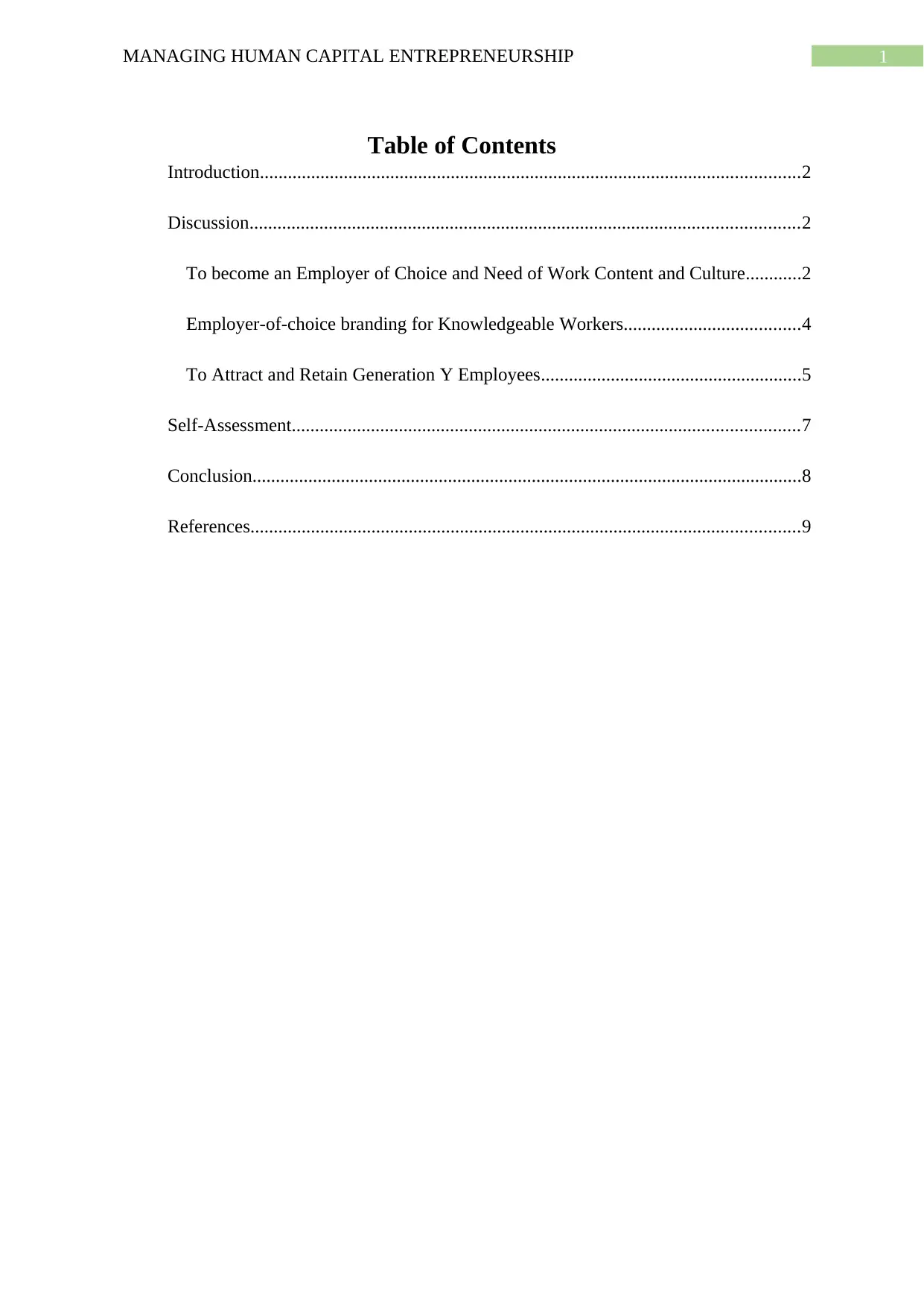
1MANAGING HUMAN CAPITAL ENTREPRENEURSHIP
Table of Contents
Introduction....................................................................................................................2
Discussion......................................................................................................................2
To become an Employer of Choice and Need of Work Content and Culture............2
Employer-of-choice branding for Knowledgeable Workers......................................4
To Attract and Retain Generation Y Employees........................................................5
Self-Assessment.............................................................................................................7
Conclusion......................................................................................................................8
References......................................................................................................................9
Table of Contents
Introduction....................................................................................................................2
Discussion......................................................................................................................2
To become an Employer of Choice and Need of Work Content and Culture............2
Employer-of-choice branding for Knowledgeable Workers......................................4
To Attract and Retain Generation Y Employees........................................................5
Self-Assessment.............................................................................................................7
Conclusion......................................................................................................................8
References......................................................................................................................9
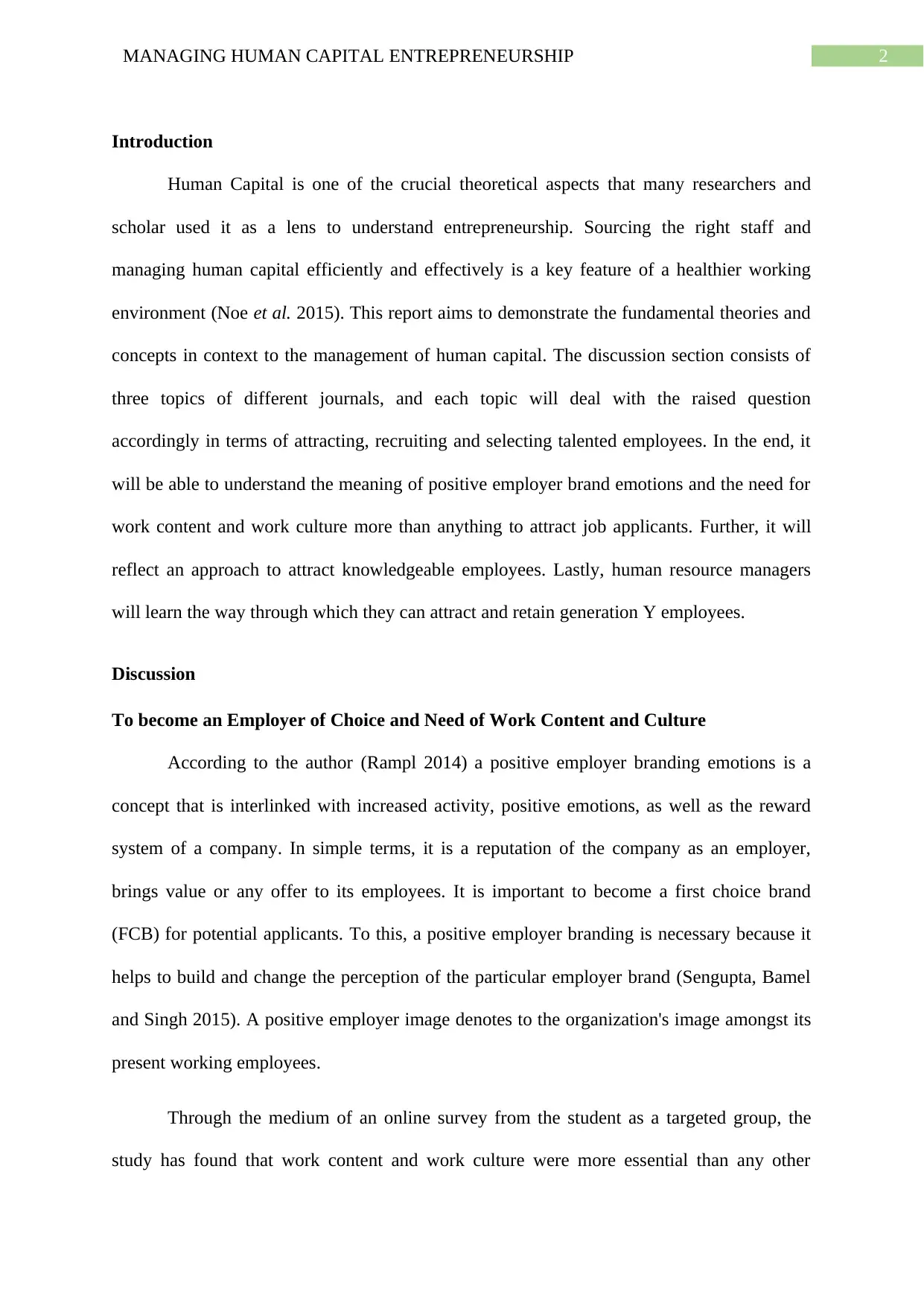
2MANAGING HUMAN CAPITAL ENTREPRENEURSHIP
Introduction
Human Capital is one of the crucial theoretical aspects that many researchers and
scholar used it as a lens to understand entrepreneurship. Sourcing the right staff and
managing human capital efficiently and effectively is a key feature of a healthier working
environment (Noe et al. 2015). This report aims to demonstrate the fundamental theories and
concepts in context to the management of human capital. The discussion section consists of
three topics of different journals, and each topic will deal with the raised question
accordingly in terms of attracting, recruiting and selecting talented employees. In the end, it
will be able to understand the meaning of positive employer brand emotions and the need for
work content and work culture more than anything to attract job applicants. Further, it will
reflect an approach to attract knowledgeable employees. Lastly, human resource managers
will learn the way through which they can attract and retain generation Y employees.
Discussion
To become an Employer of Choice and Need of Work Content and Culture
According to the author (Rampl 2014) a positive employer branding emotions is a
concept that is interlinked with increased activity, positive emotions, as well as the reward
system of a company. In simple terms, it is a reputation of the company as an employer,
brings value or any offer to its employees. It is important to become a first choice brand
(FCB) for potential applicants. To this, a positive employer branding is necessary because it
helps to build and change the perception of the particular employer brand (Sengupta, Bamel
and Singh 2015). A positive employer image denotes to the organization's image amongst its
present working employees.
Through the medium of an online survey from the student as a targeted group, the
study has found that work content and work culture were more essential than any other
Introduction
Human Capital is one of the crucial theoretical aspects that many researchers and
scholar used it as a lens to understand entrepreneurship. Sourcing the right staff and
managing human capital efficiently and effectively is a key feature of a healthier working
environment (Noe et al. 2015). This report aims to demonstrate the fundamental theories and
concepts in context to the management of human capital. The discussion section consists of
three topics of different journals, and each topic will deal with the raised question
accordingly in terms of attracting, recruiting and selecting talented employees. In the end, it
will be able to understand the meaning of positive employer brand emotions and the need for
work content and work culture more than anything to attract job applicants. Further, it will
reflect an approach to attract knowledgeable employees. Lastly, human resource managers
will learn the way through which they can attract and retain generation Y employees.
Discussion
To become an Employer of Choice and Need of Work Content and Culture
According to the author (Rampl 2014) a positive employer branding emotions is a
concept that is interlinked with increased activity, positive emotions, as well as the reward
system of a company. In simple terms, it is a reputation of the company as an employer,
brings value or any offer to its employees. It is important to become a first choice brand
(FCB) for potential applicants. To this, a positive employer branding is necessary because it
helps to build and change the perception of the particular employer brand (Sengupta, Bamel
and Singh 2015). A positive employer image denotes to the organization's image amongst its
present working employees.
Through the medium of an online survey from the student as a targeted group, the
study has found that work content and work culture were more essential than any other
⊘ This is a preview!⊘
Do you want full access?
Subscribe today to unlock all pages.

Trusted by 1+ million students worldwide
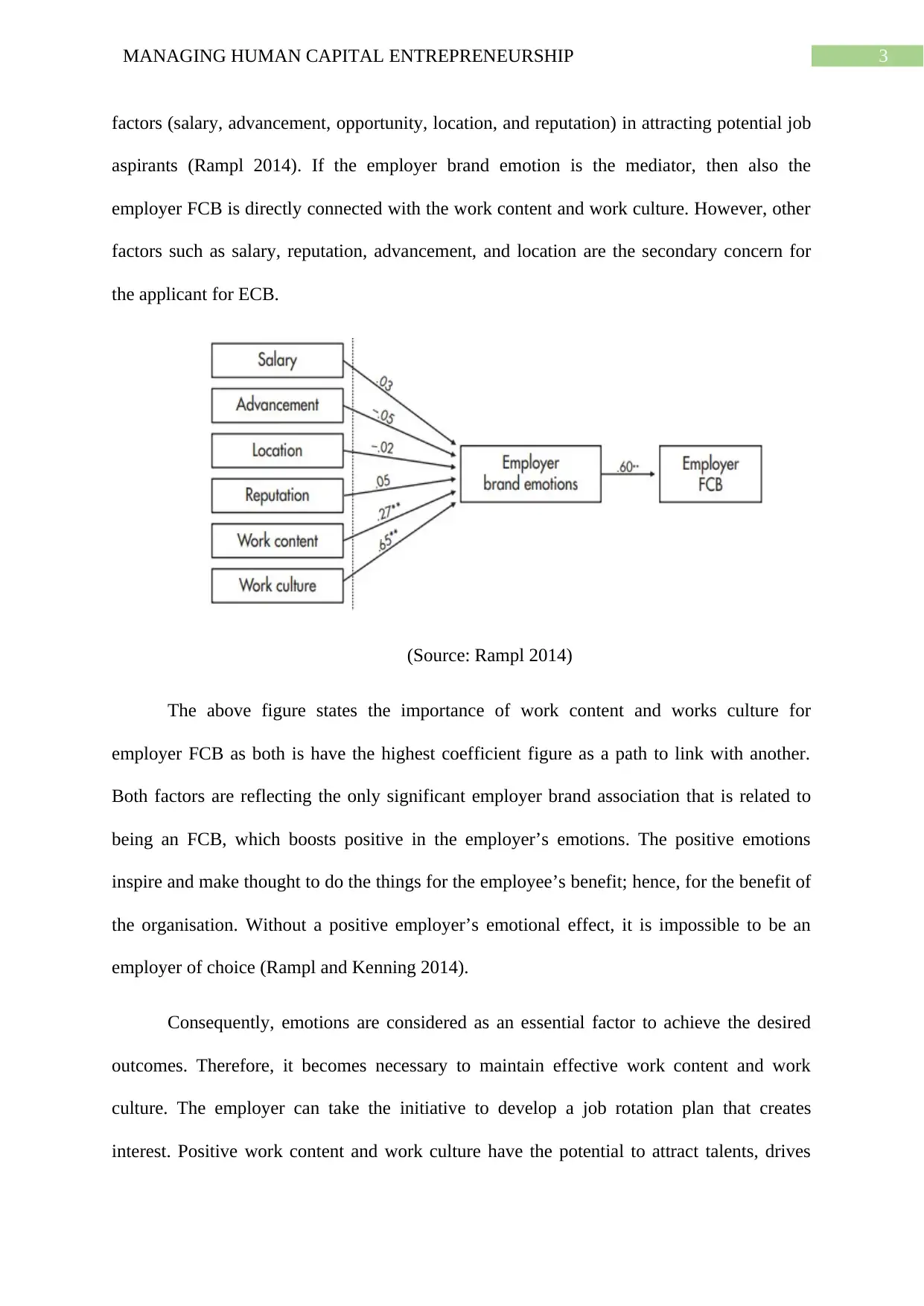
3MANAGING HUMAN CAPITAL ENTREPRENEURSHIP
factors (salary, advancement, opportunity, location, and reputation) in attracting potential job
aspirants (Rampl 2014). If the employer brand emotion is the mediator, then also the
employer FCB is directly connected with the work content and work culture. However, other
factors such as salary, reputation, advancement, and location are the secondary concern for
the applicant for ECB.
(Source: Rampl 2014)
The above figure states the importance of work content and works culture for
employer FCB as both is have the highest coefficient figure as a path to link with another.
Both factors are reflecting the only significant employer brand association that is related to
being an FCB, which boosts positive in the employer’s emotions. The positive emotions
inspire and make thought to do the things for the employee’s benefit; hence, for the benefit of
the organisation. Without a positive employer’s emotional effect, it is impossible to be an
employer of choice (Rampl and Kenning 2014).
Consequently, emotions are considered as an essential factor to achieve the desired
outcomes. Therefore, it becomes necessary to maintain effective work content and work
culture. The employer can take the initiative to develop a job rotation plan that creates
interest. Positive work content and work culture have the potential to attract talents, drives
factors (salary, advancement, opportunity, location, and reputation) in attracting potential job
aspirants (Rampl 2014). If the employer brand emotion is the mediator, then also the
employer FCB is directly connected with the work content and work culture. However, other
factors such as salary, reputation, advancement, and location are the secondary concern for
the applicant for ECB.
(Source: Rampl 2014)
The above figure states the importance of work content and works culture for
employer FCB as both is have the highest coefficient figure as a path to link with another.
Both factors are reflecting the only significant employer brand association that is related to
being an FCB, which boosts positive in the employer’s emotions. The positive emotions
inspire and make thought to do the things for the employee’s benefit; hence, for the benefit of
the organisation. Without a positive employer’s emotional effect, it is impossible to be an
employer of choice (Rampl and Kenning 2014).
Consequently, emotions are considered as an essential factor to achieve the desired
outcomes. Therefore, it becomes necessary to maintain effective work content and work
culture. The employer can take the initiative to develop a job rotation plan that creates
interest. Positive work content and work culture have the potential to attract talents, drives
Paraphrase This Document
Need a fresh take? Get an instant paraphrase of this document with our AI Paraphraser
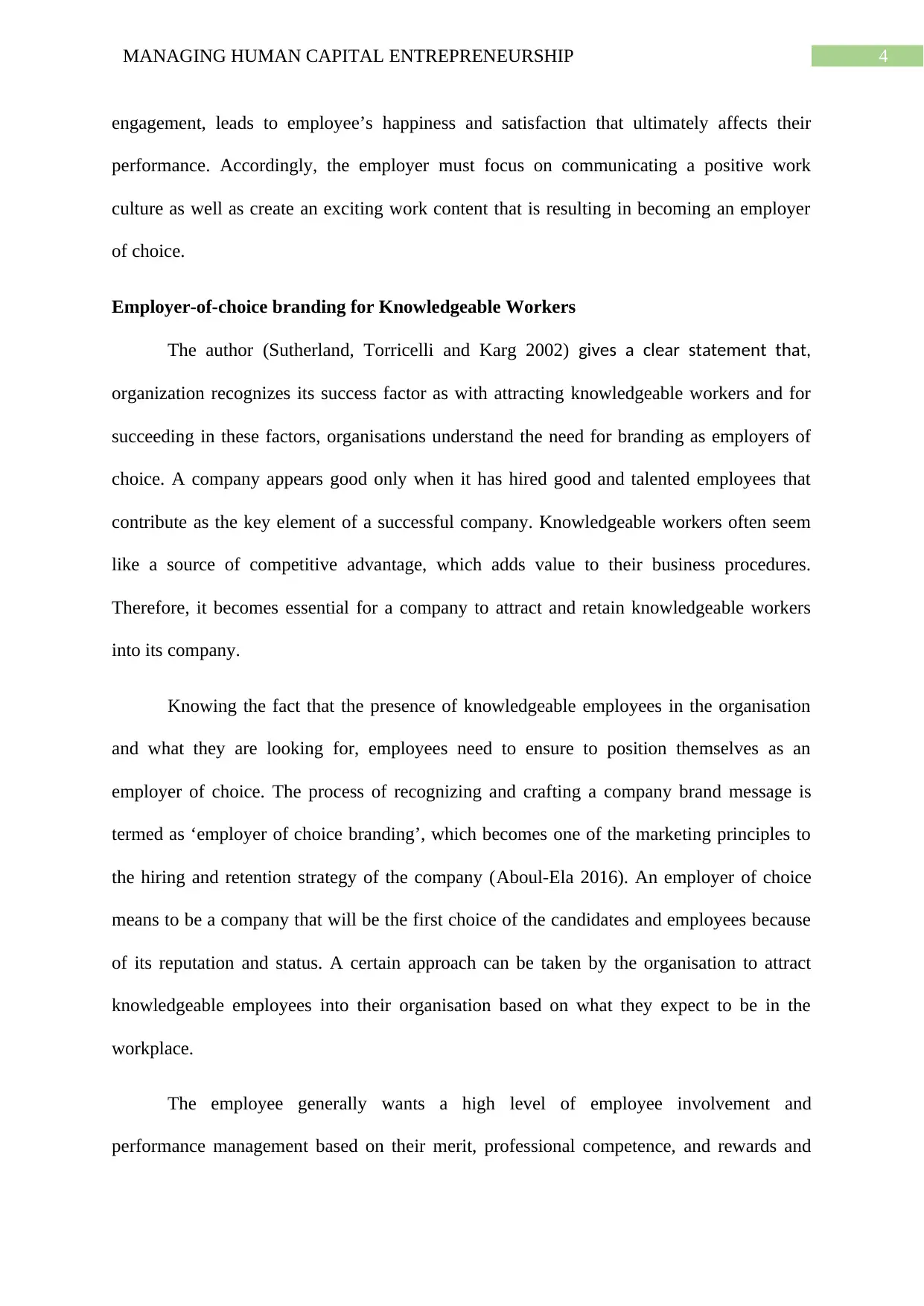
4MANAGING HUMAN CAPITAL ENTREPRENEURSHIP
engagement, leads to employee’s happiness and satisfaction that ultimately affects their
performance. Accordingly, the employer must focus on communicating a positive work
culture as well as create an exciting work content that is resulting in becoming an employer
of choice.
Employer-of-choice branding for Knowledgeable Workers
The author (Sutherland, Torricelli and Karg 2002) gives a clear statement that,
organization recognizes its success factor as with attracting knowledgeable workers and for
succeeding in these factors, organisations understand the need for branding as employers of
choice. A company appears good only when it has hired good and talented employees that
contribute as the key element of a successful company. Knowledgeable workers often seem
like a source of competitive advantage, which adds value to their business procedures.
Therefore, it becomes essential for a company to attract and retain knowledgeable workers
into its company.
Knowing the fact that the presence of knowledgeable employees in the organisation
and what they are looking for, employees need to ensure to position themselves as an
employer of choice. The process of recognizing and crafting a company brand message is
termed as ‘employer of choice branding’, which becomes one of the marketing principles to
the hiring and retention strategy of the company (Aboul-Ela 2016). An employer of choice
means to be a company that will be the first choice of the candidates and employees because
of its reputation and status. A certain approach can be taken by the organisation to attract
knowledgeable employees into their organisation based on what they expect to be in the
workplace.
The employee generally wants a high level of employee involvement and
performance management based on their merit, professional competence, and rewards and
engagement, leads to employee’s happiness and satisfaction that ultimately affects their
performance. Accordingly, the employer must focus on communicating a positive work
culture as well as create an exciting work content that is resulting in becoming an employer
of choice.
Employer-of-choice branding for Knowledgeable Workers
The author (Sutherland, Torricelli and Karg 2002) gives a clear statement that,
organization recognizes its success factor as with attracting knowledgeable workers and for
succeeding in these factors, organisations understand the need for branding as employers of
choice. A company appears good only when it has hired good and talented employees that
contribute as the key element of a successful company. Knowledgeable workers often seem
like a source of competitive advantage, which adds value to their business procedures.
Therefore, it becomes essential for a company to attract and retain knowledgeable workers
into its company.
Knowing the fact that the presence of knowledgeable employees in the organisation
and what they are looking for, employees need to ensure to position themselves as an
employer of choice. The process of recognizing and crafting a company brand message is
termed as ‘employer of choice branding’, which becomes one of the marketing principles to
the hiring and retention strategy of the company (Aboul-Ela 2016). An employer of choice
means to be a company that will be the first choice of the candidates and employees because
of its reputation and status. A certain approach can be taken by the organisation to attract
knowledgeable employees into their organisation based on what they expect to be in the
workplace.
The employee generally wants a high level of employee involvement and
performance management based on their merit, professional competence, and rewards and

5MANAGING HUMAN CAPITAL ENTREPRENEURSHIP
more important a management that performs with integrity and caring. The essential factors
that a knowledgeable employee gives importance are the reputation of the company, culture,
leadership, behavior, and treatment with people, career growth and opportunity, work
content, compensation, and benefits.
A good communication system is the most preferable and common feature of
employers of choice. Employer branding requires communicating its formulated strategy
within and outside the organisation. Internal conditions will tend to make its impression on
the internal peoples and outer audience from communicating and word of mouth. In the
current competitive era, talent and knowledge are essential for value creation (Hauff,
Alewell and Katrin Hansen 2017). The challenge for the organisation is how to attract these
knowledgeable people to the organisation. Organisation’s initial step is to understand what
these talents value the most.
Therefore, it becomes important for the employers to initiate these approaches to hire
knowledgeable workers that can add value to their organization. They also need to understand
their requirements and implement such within the organization so that to attract and retain
talented employees into their organization.
To Attract and Retain Generation Y Employees
As per the author (Wong, Wan and Gao 2017). The employees can inspire to get into
a certain organisation and retain themselves through different factors. The hierarchical nature
of Generation Y motives for work concept reflects outcomes from the meaning of work and
the commitment. The human resource management must understand the career choice of
Generation Y so that they can be able to attract and retain them and help themselves
eliminating the shortage of workforce issue.
more important a management that performs with integrity and caring. The essential factors
that a knowledgeable employee gives importance are the reputation of the company, culture,
leadership, behavior, and treatment with people, career growth and opportunity, work
content, compensation, and benefits.
A good communication system is the most preferable and common feature of
employers of choice. Employer branding requires communicating its formulated strategy
within and outside the organisation. Internal conditions will tend to make its impression on
the internal peoples and outer audience from communicating and word of mouth. In the
current competitive era, talent and knowledge are essential for value creation (Hauff,
Alewell and Katrin Hansen 2017). The challenge for the organisation is how to attract these
knowledgeable people to the organisation. Organisation’s initial step is to understand what
these talents value the most.
Therefore, it becomes important for the employers to initiate these approaches to hire
knowledgeable workers that can add value to their organization. They also need to understand
their requirements and implement such within the organization so that to attract and retain
talented employees into their organization.
To Attract and Retain Generation Y Employees
As per the author (Wong, Wan and Gao 2017). The employees can inspire to get into
a certain organisation and retain themselves through different factors. The hierarchical nature
of Generation Y motives for work concept reflects outcomes from the meaning of work and
the commitment. The human resource management must understand the career choice of
Generation Y so that they can be able to attract and retain them and help themselves
eliminating the shortage of workforce issue.
⊘ This is a preview!⊘
Do you want full access?
Subscribe today to unlock all pages.

Trusted by 1+ million students worldwide
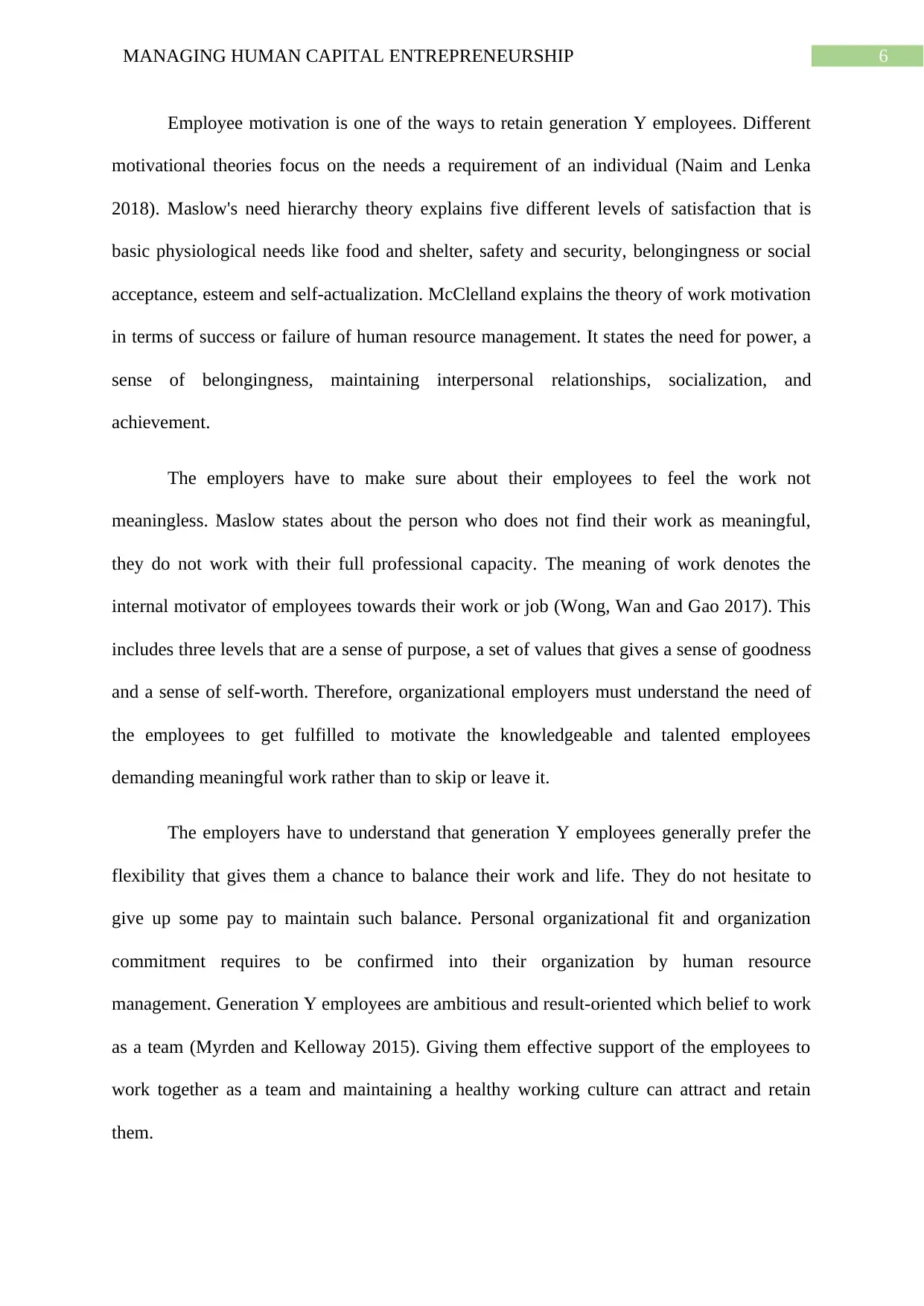
6MANAGING HUMAN CAPITAL ENTREPRENEURSHIP
Employee motivation is one of the ways to retain generation Y employees. Different
motivational theories focus on the needs a requirement of an individual (Naim and Lenka
2018). Maslow's need hierarchy theory explains five different levels of satisfaction that is
basic physiological needs like food and shelter, safety and security, belongingness or social
acceptance, esteem and self-actualization. McClelland explains the theory of work motivation
in terms of success or failure of human resource management. It states the need for power, a
sense of belongingness, maintaining interpersonal relationships, socialization, and
achievement.
The employers have to make sure about their employees to feel the work not
meaningless. Maslow states about the person who does not find their work as meaningful,
they do not work with their full professional capacity. The meaning of work denotes the
internal motivator of employees towards their work or job (Wong, Wan and Gao 2017). This
includes three levels that are a sense of purpose, a set of values that gives a sense of goodness
and a sense of self-worth. Therefore, organizational employers must understand the need of
the employees to get fulfilled to motivate the knowledgeable and talented employees
demanding meaningful work rather than to skip or leave it.
The employers have to understand that generation Y employees generally prefer the
flexibility that gives them a chance to balance their work and life. They do not hesitate to
give up some pay to maintain such balance. Personal organizational fit and organization
commitment requires to be confirmed into their organization by human resource
management. Generation Y employees are ambitious and result-oriented which belief to work
as a team (Myrden and Kelloway 2015). Giving them effective support of the employees to
work together as a team and maintaining a healthy working culture can attract and retain
them.
Employee motivation is one of the ways to retain generation Y employees. Different
motivational theories focus on the needs a requirement of an individual (Naim and Lenka
2018). Maslow's need hierarchy theory explains five different levels of satisfaction that is
basic physiological needs like food and shelter, safety and security, belongingness or social
acceptance, esteem and self-actualization. McClelland explains the theory of work motivation
in terms of success or failure of human resource management. It states the need for power, a
sense of belongingness, maintaining interpersonal relationships, socialization, and
achievement.
The employers have to make sure about their employees to feel the work not
meaningless. Maslow states about the person who does not find their work as meaningful,
they do not work with their full professional capacity. The meaning of work denotes the
internal motivator of employees towards their work or job (Wong, Wan and Gao 2017). This
includes three levels that are a sense of purpose, a set of values that gives a sense of goodness
and a sense of self-worth. Therefore, organizational employers must understand the need of
the employees to get fulfilled to motivate the knowledgeable and talented employees
demanding meaningful work rather than to skip or leave it.
The employers have to understand that generation Y employees generally prefer the
flexibility that gives them a chance to balance their work and life. They do not hesitate to
give up some pay to maintain such balance. Personal organizational fit and organization
commitment requires to be confirmed into their organization by human resource
management. Generation Y employees are ambitious and result-oriented which belief to work
as a team (Myrden and Kelloway 2015). Giving them effective support of the employees to
work together as a team and maintaining a healthy working culture can attract and retain
them.
Paraphrase This Document
Need a fresh take? Get an instant paraphrase of this document with our AI Paraphraser
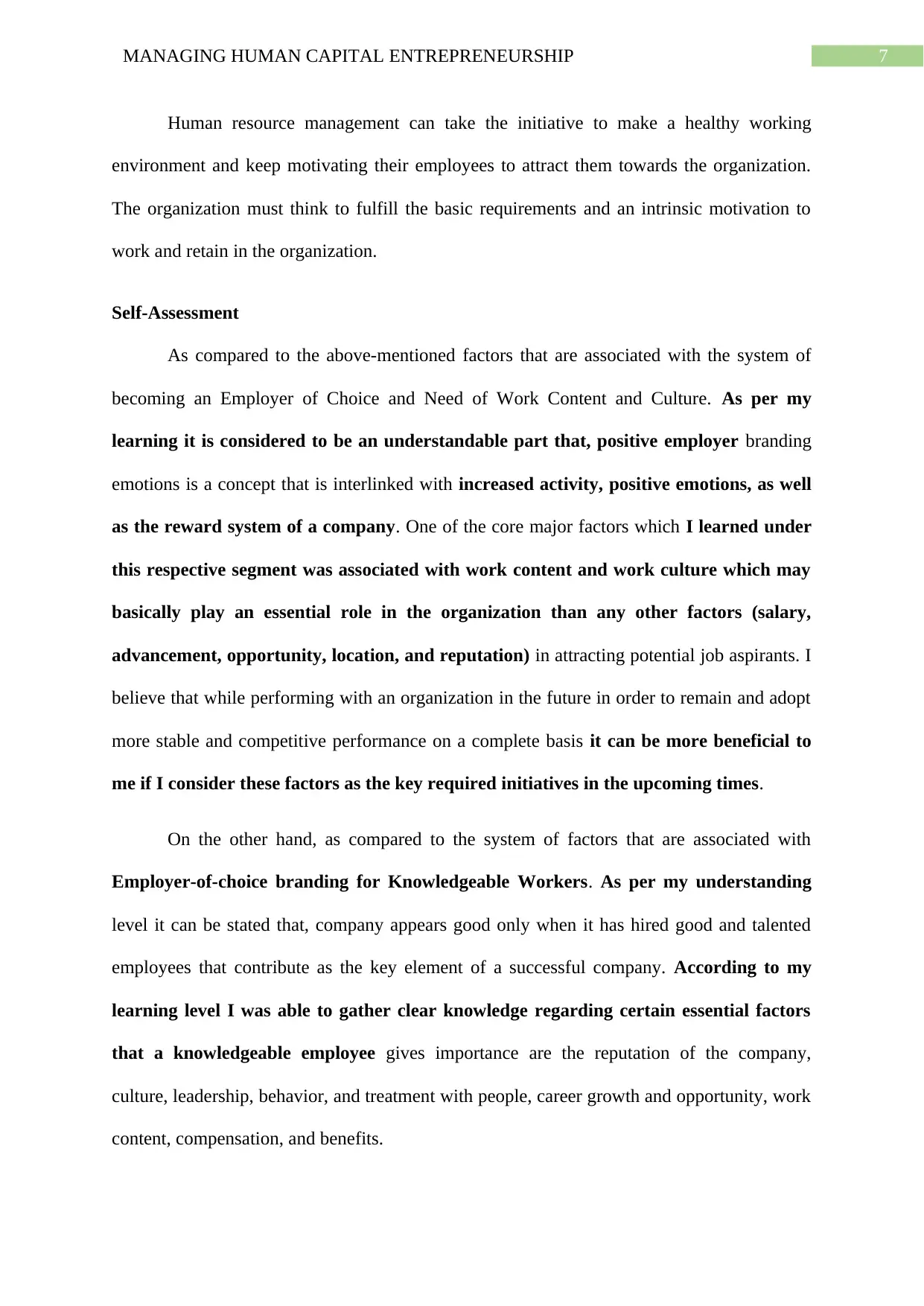
7MANAGING HUMAN CAPITAL ENTREPRENEURSHIP
Human resource management can take the initiative to make a healthy working
environment and keep motivating their employees to attract them towards the organization.
The organization must think to fulfill the basic requirements and an intrinsic motivation to
work and retain in the organization.
Self-Assessment
As compared to the above-mentioned factors that are associated with the system of
becoming an Employer of Choice and Need of Work Content and Culture. As per my
learning it is considered to be an understandable part that, positive employer branding
emotions is a concept that is interlinked with increased activity, positive emotions, as well
as the reward system of a company. One of the core major factors which I learned under
this respective segment was associated with work content and work culture which may
basically play an essential role in the organization than any other factors (salary,
advancement, opportunity, location, and reputation) in attracting potential job aspirants. I
believe that while performing with an organization in the future in order to remain and adopt
more stable and competitive performance on a complete basis it can be more beneficial to
me if I consider these factors as the key required initiatives in the upcoming times.
On the other hand, as compared to the system of factors that are associated with
Employer-of-choice branding for Knowledgeable Workers. As per my understanding
level it can be stated that, company appears good only when it has hired good and talented
employees that contribute as the key element of a successful company. According to my
learning level I was able to gather clear knowledge regarding certain essential factors
that a knowledgeable employee gives importance are the reputation of the company,
culture, leadership, behavior, and treatment with people, career growth and opportunity, work
content, compensation, and benefits.
Human resource management can take the initiative to make a healthy working
environment and keep motivating their employees to attract them towards the organization.
The organization must think to fulfill the basic requirements and an intrinsic motivation to
work and retain in the organization.
Self-Assessment
As compared to the above-mentioned factors that are associated with the system of
becoming an Employer of Choice and Need of Work Content and Culture. As per my
learning it is considered to be an understandable part that, positive employer branding
emotions is a concept that is interlinked with increased activity, positive emotions, as well
as the reward system of a company. One of the core major factors which I learned under
this respective segment was associated with work content and work culture which may
basically play an essential role in the organization than any other factors (salary,
advancement, opportunity, location, and reputation) in attracting potential job aspirants. I
believe that while performing with an organization in the future in order to remain and adopt
more stable and competitive performance on a complete basis it can be more beneficial to
me if I consider these factors as the key required initiatives in the upcoming times.
On the other hand, as compared to the system of factors that are associated with
Employer-of-choice branding for Knowledgeable Workers. As per my understanding
level it can be stated that, company appears good only when it has hired good and talented
employees that contribute as the key element of a successful company. According to my
learning level I was able to gather clear knowledge regarding certain essential factors
that a knowledgeable employee gives importance are the reputation of the company,
culture, leadership, behavior, and treatment with people, career growth and opportunity, work
content, compensation, and benefits.
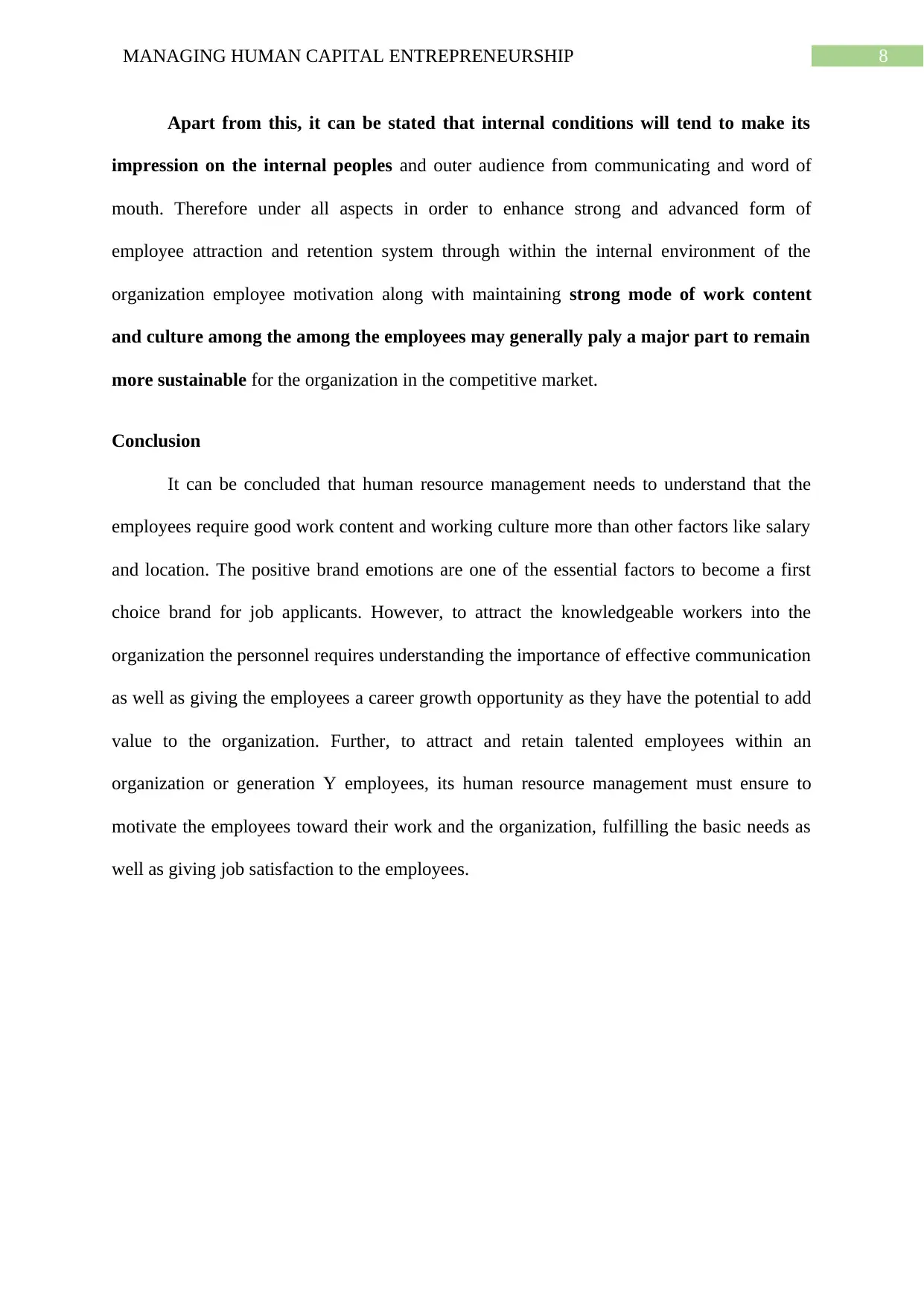
8MANAGING HUMAN CAPITAL ENTREPRENEURSHIP
Apart from this, it can be stated that internal conditions will tend to make its
impression on the internal peoples and outer audience from communicating and word of
mouth. Therefore under all aspects in order to enhance strong and advanced form of
employee attraction and retention system through within the internal environment of the
organization employee motivation along with maintaining strong mode of work content
and culture among the among the employees may generally paly a major part to remain
more sustainable for the organization in the competitive market.
Conclusion
It can be concluded that human resource management needs to understand that the
employees require good work content and working culture more than other factors like salary
and location. The positive brand emotions are one of the essential factors to become a first
choice brand for job applicants. However, to attract the knowledgeable workers into the
organization the personnel requires understanding the importance of effective communication
as well as giving the employees a career growth opportunity as they have the potential to add
value to the organization. Further, to attract and retain talented employees within an
organization or generation Y employees, its human resource management must ensure to
motivate the employees toward their work and the organization, fulfilling the basic needs as
well as giving job satisfaction to the employees.
Apart from this, it can be stated that internal conditions will tend to make its
impression on the internal peoples and outer audience from communicating and word of
mouth. Therefore under all aspects in order to enhance strong and advanced form of
employee attraction and retention system through within the internal environment of the
organization employee motivation along with maintaining strong mode of work content
and culture among the among the employees may generally paly a major part to remain
more sustainable for the organization in the competitive market.
Conclusion
It can be concluded that human resource management needs to understand that the
employees require good work content and working culture more than other factors like salary
and location. The positive brand emotions are one of the essential factors to become a first
choice brand for job applicants. However, to attract the knowledgeable workers into the
organization the personnel requires understanding the importance of effective communication
as well as giving the employees a career growth opportunity as they have the potential to add
value to the organization. Further, to attract and retain talented employees within an
organization or generation Y employees, its human resource management must ensure to
motivate the employees toward their work and the organization, fulfilling the basic needs as
well as giving job satisfaction to the employees.
⊘ This is a preview!⊘
Do you want full access?
Subscribe today to unlock all pages.

Trusted by 1+ million students worldwide
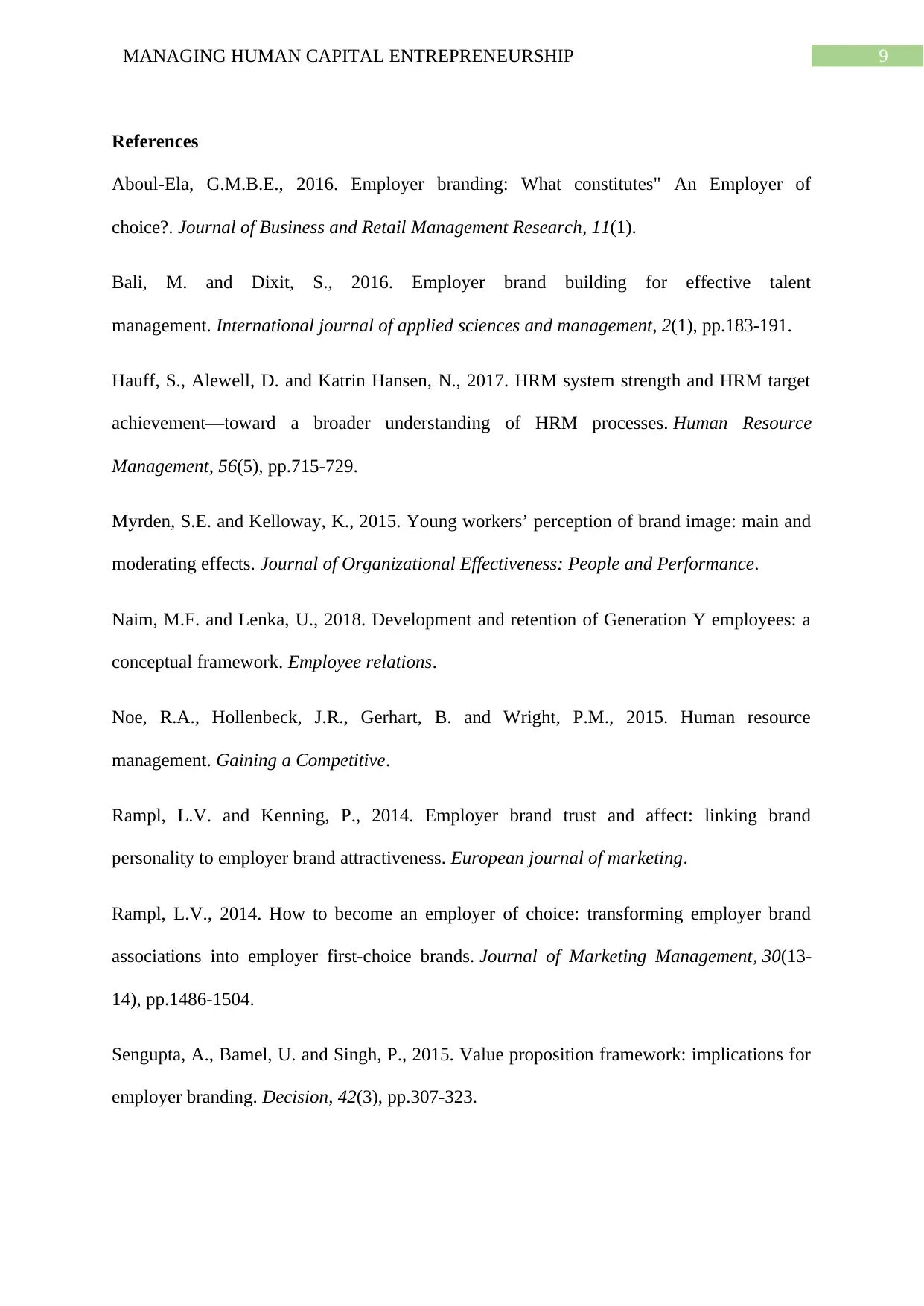
9MANAGING HUMAN CAPITAL ENTREPRENEURSHIP
References
Aboul-Ela, G.M.B.E., 2016. Employer branding: What constitutes" An Employer of
choice?. Journal of Business and Retail Management Research, 11(1).
Bali, M. and Dixit, S., 2016. Employer brand building for effective talent
management. International journal of applied sciences and management, 2(1), pp.183-191.
Hauff, S., Alewell, D. and Katrin Hansen, N., 2017. HRM system strength and HRM target
achievement—toward a broader understanding of HRM processes. Human Resource
Management, 56(5), pp.715-729.
Myrden, S.E. and Kelloway, K., 2015. Young workers’ perception of brand image: main and
moderating effects. Journal of Organizational Effectiveness: People and Performance.
Naim, M.F. and Lenka, U., 2018. Development and retention of Generation Y employees: a
conceptual framework. Employee relations.
Noe, R.A., Hollenbeck, J.R., Gerhart, B. and Wright, P.M., 2015. Human resource
management. Gaining a Competitive.
Rampl, L.V. and Kenning, P., 2014. Employer brand trust and affect: linking brand
personality to employer brand attractiveness. European journal of marketing.
Rampl, L.V., 2014. How to become an employer of choice: transforming employer brand
associations into employer first-choice brands. Journal of Marketing Management, 30(13-
14), pp.1486-1504.
Sengupta, A., Bamel, U. and Singh, P., 2015. Value proposition framework: implications for
employer branding. Decision, 42(3), pp.307-323.
References
Aboul-Ela, G.M.B.E., 2016. Employer branding: What constitutes" An Employer of
choice?. Journal of Business and Retail Management Research, 11(1).
Bali, M. and Dixit, S., 2016. Employer brand building for effective talent
management. International journal of applied sciences and management, 2(1), pp.183-191.
Hauff, S., Alewell, D. and Katrin Hansen, N., 2017. HRM system strength and HRM target
achievement—toward a broader understanding of HRM processes. Human Resource
Management, 56(5), pp.715-729.
Myrden, S.E. and Kelloway, K., 2015. Young workers’ perception of brand image: main and
moderating effects. Journal of Organizational Effectiveness: People and Performance.
Naim, M.F. and Lenka, U., 2018. Development and retention of Generation Y employees: a
conceptual framework. Employee relations.
Noe, R.A., Hollenbeck, J.R., Gerhart, B. and Wright, P.M., 2015. Human resource
management. Gaining a Competitive.
Rampl, L.V. and Kenning, P., 2014. Employer brand trust and affect: linking brand
personality to employer brand attractiveness. European journal of marketing.
Rampl, L.V., 2014. How to become an employer of choice: transforming employer brand
associations into employer first-choice brands. Journal of Marketing Management, 30(13-
14), pp.1486-1504.
Sengupta, A., Bamel, U. and Singh, P., 2015. Value proposition framework: implications for
employer branding. Decision, 42(3), pp.307-323.
Paraphrase This Document
Need a fresh take? Get an instant paraphrase of this document with our AI Paraphraser
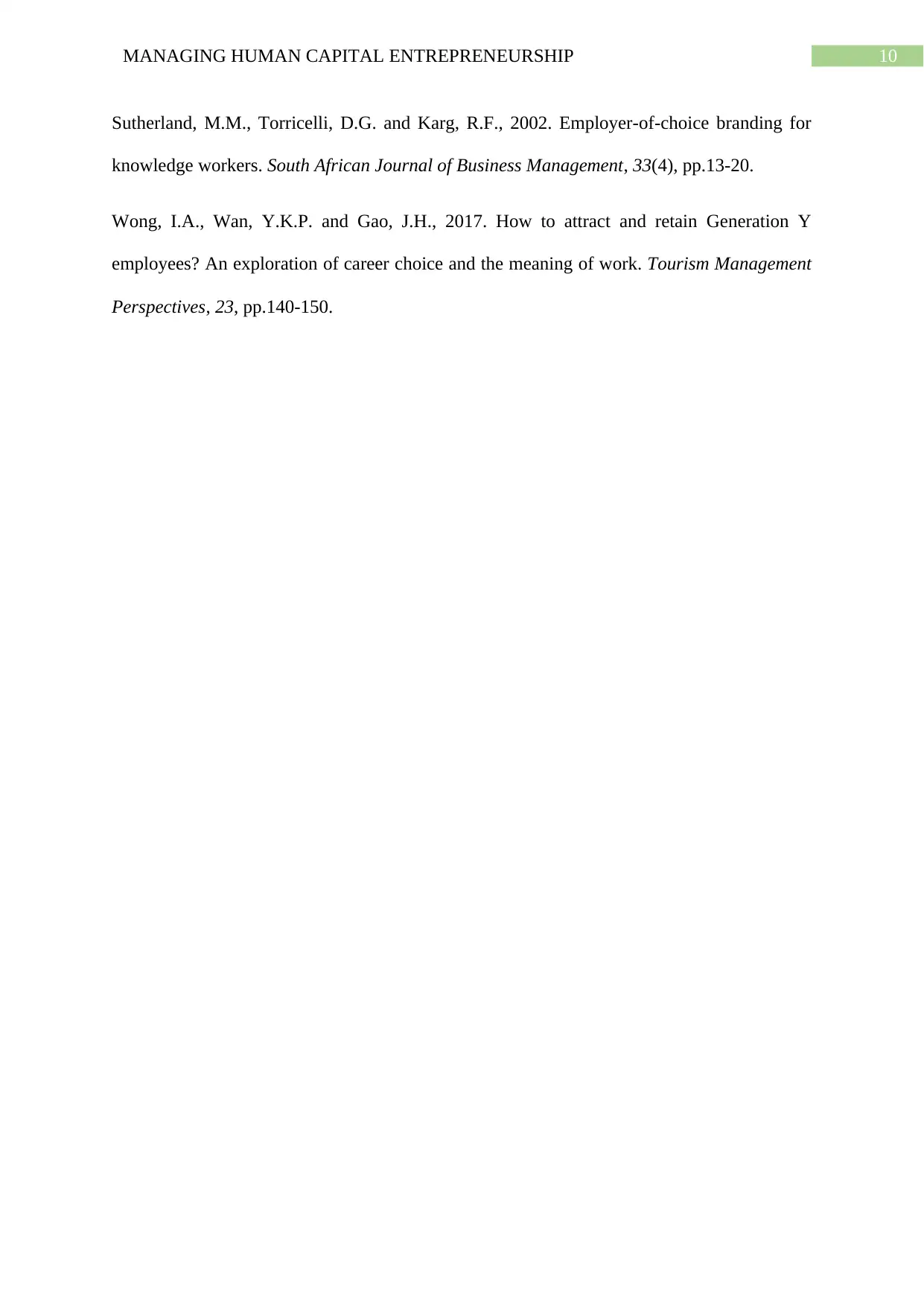
10MANAGING HUMAN CAPITAL ENTREPRENEURSHIP
Sutherland, M.M., Torricelli, D.G. and Karg, R.F., 2002. Employer-of-choice branding for
knowledge workers. South African Journal of Business Management, 33(4), pp.13-20.
Wong, I.A., Wan, Y.K.P. and Gao, J.H., 2017. How to attract and retain Generation Y
employees? An exploration of career choice and the meaning of work. Tourism Management
Perspectives, 23, pp.140-150.
Sutherland, M.M., Torricelli, D.G. and Karg, R.F., 2002. Employer-of-choice branding for
knowledge workers. South African Journal of Business Management, 33(4), pp.13-20.
Wong, I.A., Wan, Y.K.P. and Gao, J.H., 2017. How to attract and retain Generation Y
employees? An exploration of career choice and the meaning of work. Tourism Management
Perspectives, 23, pp.140-150.
1 out of 11
Related Documents
Your All-in-One AI-Powered Toolkit for Academic Success.
+13062052269
info@desklib.com
Available 24*7 on WhatsApp / Email
![[object Object]](/_next/static/media/star-bottom.7253800d.svg)
Unlock your academic potential
Copyright © 2020–2025 A2Z Services. All Rights Reserved. Developed and managed by ZUCOL.





